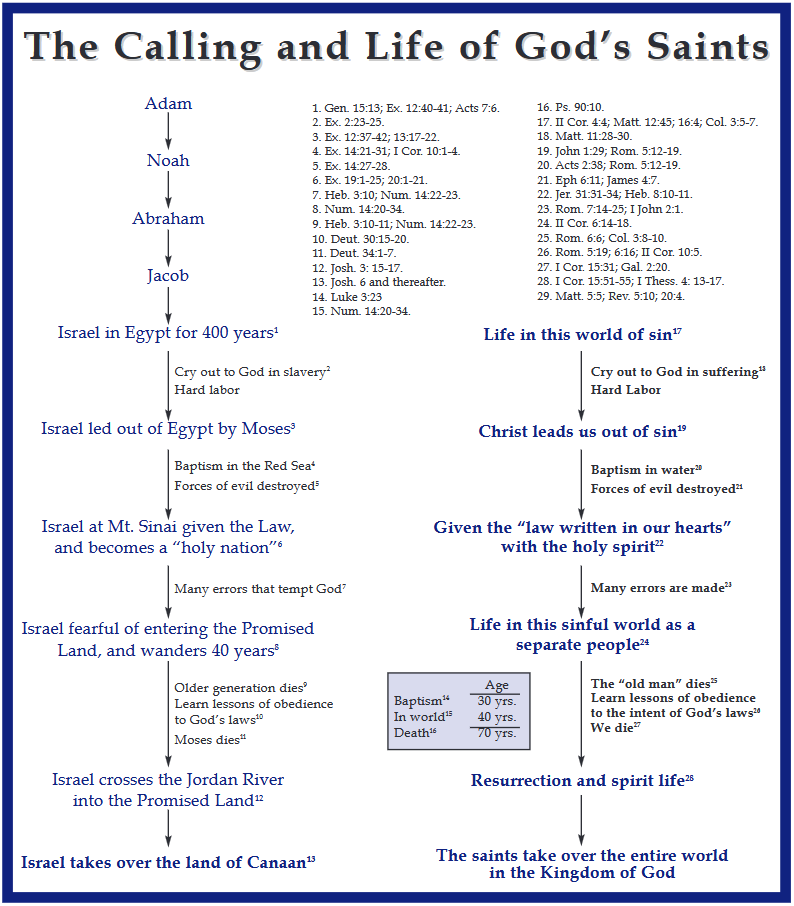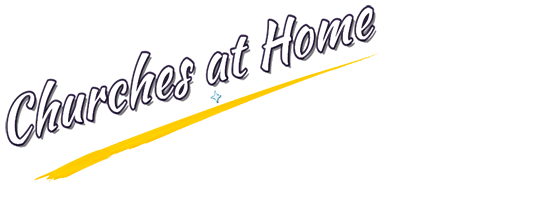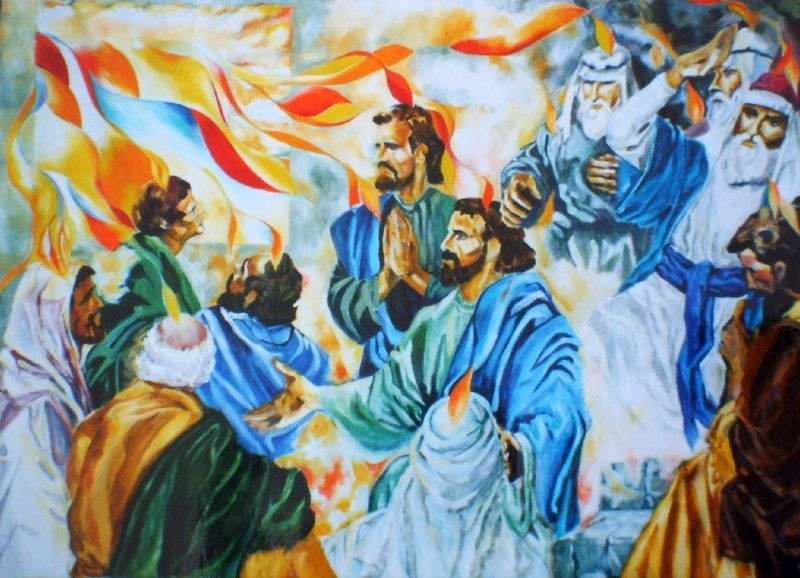
Pentecost, An Incredibly Important Feast for God’s People
Each year in the late spring we keep a second major annual festival, a solemn åfeast along with Unleavened Bread and Tabernacles on which all males are to appear (Deut. 16:16). The names given to this day are as follows:
1. Hag Hashavuot (Hebrew), meaning “the Feast of Weeks” (Exodus 34:22; Deuteronomy 16:10; II Chronicles 8:13).
2. Yom Habikkurim (Hebrew), meaning “the Day of Firstfruits” (Numbers 28:26).
3. Hag Hakatzir (Hebrew), meaning “the Feast of Harvest” (Exodus 23:16), showing this day as the official beginning of the summer harvest season.
4. Pentecost (English translation from the Greek pentkoste), meaning “fiftieth”, the New Testament term for the Feast of Weeks (Acts 2:1; 20:16; I Corinthians 16:18)
When are God’s people to keep the day? Seven weeks are counted from the Wave Sheaf Offering day during the Feast of Firstfruits (Lev. 23:15-16). Why count from the Wave Sheaf Offering day? We understand that the sheaf was waved on the day after the weekly Sabbath day (Leviticus 23:11), and seven Sabbaths shall be complete (8549 = tamiym, “entire”), implying complete weekly cycles with the final (seventh) Sabbath ending the period, after which the fiftieth day is the first day of the week (Leviticus 23:15). This is the way that the Sadducees, the priestly party in Israel, counted the days, whereas the Pharisees counted from the day after the first day of Unleavened Bread. Some few count starting the day after the Wave Sheaf Offering, but there seems to be little support for such a method of counting.
The Sacrifices and Symbols of the Day
Several offerings were commanded for ancient Israel, including the following:
1. Meat [meal] offering (Leviticus 23:16).
2. Two loaves of bread made with fine flour (0.2 deal each) baked with leaven, representing the firstfruits to Yahweh (Leviticus 23:17). The two loaves may mean Jesus Christ (the first of the firstfruits) and the saints (the firstfruits), the pre-Christ and post-Christ ecclesia, Hebrews and Gentiles, or possibly something else.
a. To be offered with seven unblemished yearling lambs (Leviticus 23:18-20).
b. One young bullock.
c. Two rams.
d. Offered along with their meat [meal] offering and drink offerings, which were burned. The wave loaves were waved backwards and forwards, then up and down, and afterwards were set aside “for the priest” (Leviticus 23:20) to comprise the festive meal eaten by the priests later that day in the Temple. No leaven or honey were burned on the alter, since Yahweh had forbidden leaven on the altar (Leviticus 2:11). [Only sinless lives, those redeemed by Christ’s blood, are unleavened, so only they can be sacrificed on the altar, not leavened, sinful lives (Romans 12:1; Galatians 2:20)].
e. One goat kid as an offering.
f. Two yearling lambs as a peace offering, waved by the priest with the bread of the firstfruits as a wave offering, with the two lambs, holy to Yahweh for the priest. These terms and symbols are familiar to us.
Firstfruits = Christ and the saints (I Corinthians 15:23; Revelation 14:4).
Smoke and sweet savor = prayers of the saints (Revelation 8:3-4).
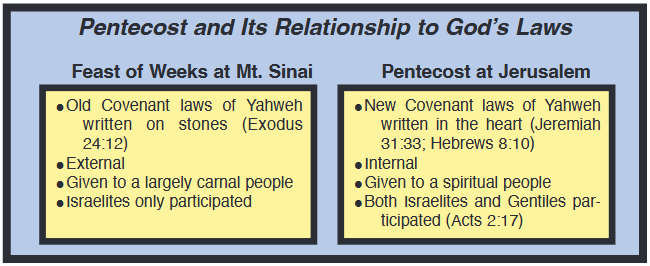
The day was to be a holy convocation (Leviticus 23:21), during which no servile work was to be done throughout Israel’s generations (Leviticus 23:21; Numbers 28:26). The day the Wave Sheaf was offered signaled the beginning of the barley harvest (Leviticus 23:11), just as the Feast of Weeks marked the beginning of the wheat harvest (Deuteronomy 16:10). Both of these grains symbolize the saints.
1. Wheat = God’s elect. See the Parable of the Sower (Matthew 13:23), and the Parable of the Wheat and Tares (Matthew 13:24-30, 37-43).
2. Barley = God’s elect as well, who were waved before Yahweh during the Feast of Unleavened Bread (Leviticus 23:10-11).
Meanings Behind The Feast of Weeks and Pentecost
The Feast of Weeks (Pentecost) has as its central focus the message of Joel 2:28-32:
“And it shall come to pass afterward that I will pour out my spirit upon all flesh, and your sons and your daughters shall prophesy, and your old men shall dream dreams; your young men shall see visions: and also upon the servants and upon the handmaids in those days will I pour out My spirit. And [much later] I will show wonders in the heavens and in the earth: blood and fire and pillars of smoke. The sun shall be turned into darkness and the moon into blood before the great and terrible day of the Lord comes. And it shall come to pass that whosoever shall call on the name of the Lord shall be delivered, for in mount Zion and in Jerusalem shall be deliverance, as the Lord has said, and in the remnant whom the Lord shall call”.
Acts 2:17 says these things [speaking in tongues, and the pouring out of God’s spirit in Jerusalem: Acts 2:14-15] occurred in “… the last days …”, which was at the first Pentecost after Christ’s resurrection, around 30 A.D. The “last days” are interpreted as the last half of the 7,000-year “week” of this aeon, and 30 A.D. is well within this time period. It is at this Pentecost and after that the Gentiles began to be “grafted in” (Romans 11:17), so this point in time is a remarkable pivotal point in the plan of God. Now all of mankind whom God had foreordained would be called and chosen to receive the spirit of God, to become a part of the ecclesia. Before this time there is no record of anyone outside of the line of Abraham, Isaac, and Jacob who received God’s spirit. The two groups of individuals in the ecclesia — Israelites and Gentiles — may thus be represented by the two “wave loaves” offered before the Lord at the Feast of Weeks, for they are the “… firstfruits unto the Lord…”, the firstfruits being those called into the ecclesia as brothers of Jesus Christ.
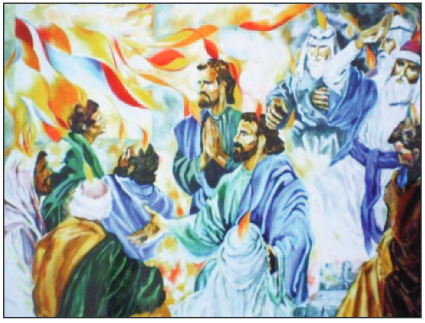 Pentecost takes on even more meaning when one realizes that just as the Passover and the Days of Unleavened Bread typify the beginning of the barley harvest — the Israelite harvest — so the Feast of Weeks typifies the beginning of the wheat harvest — the Gentile harvest. Not until these festivals had passed was any new grain consumed by Israelites in either the spring or the summer. Both festivals mark awesome events: the giving of God’s spirit to live within those destined to become kings and priests (Hebrews 8:10) alongside Jesus Christ for a thousand years, and then forevermore.
Pentecost takes on even more meaning when one realizes that just as the Passover and the Days of Unleavened Bread typify the beginning of the barley harvest — the Israelite harvest — so the Feast of Weeks typifies the beginning of the wheat harvest — the Gentile harvest. Not until these festivals had passed was any new grain consumed by Israelites in either the spring or the summer. Both festivals mark awesome events: the giving of God’s spirit to live within those destined to become kings and priests (Hebrews 8:10) alongside Jesus Christ for a thousand years, and then forevermore.
We Are to Become Kings and Priests!
What does it mean to be a king and a priest? After Israel left Egypt during the Days of Unleavened Bread they arrived at Mt. Sinai in the third month. This time corresponds to the Feast of Weeks (O.T.) or the Day of Pentecost (N.T.). Moses climbed up the mountain and met the Lord (Yahweh), and was told to tell Israel, “You have seen what I did unto the Egyptians, and how I bore you on eagle’s wings, and brought you unto myself. Now therefore, if you will obey My voice indeed, and keep My covenant, then you shall be a peculiar treasure to Me above all people, for all the earth is Mine. And you shall be unto Me a kingdom of priests, and a holy nation” (Exodus 19:3-6).
Peculiar treasure (Strong 5459) = cegullah, “to shut up; wealth (as closely shut up)”; translated “jewel, peculiar treasure, proper good, special.”
kingdom (Strong 4467) = mamlakah, ”dominion, i.e. the estate or country”; from Strong 4427, malak, “to reign to ascend the throne, to induct into royalty.”
priests (Strong 3548) = kohen, “one officiating, a priest.”
Peter reiterated this promise to the ecclesia, “spiritual Israel” as it were:
“But you are a chosen generation, a royal priesthood, a holy nation, a peculiar people that you should show forth the praises of Him who has called you out of darkness into marvelous light, which in times past was not a people but are now the people of God ….” I Peter 2:9-10.
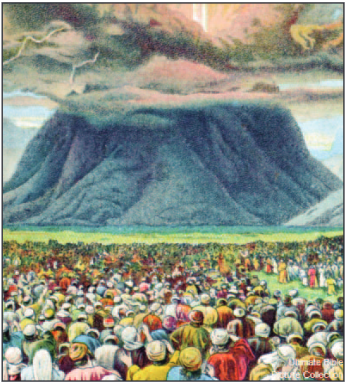 We also know that “… all Israel shall be saved …” ultimately, and given eternal life and priestly status in the next age (Romans 11:26). Thus, the New Covenant promise of Sonship in the Kingdom is identical to the one given by the Lord on Mt. Sinai over 1,500 years earlier. The symbolism of the Israelites’ encounter with Yahweh at Mt. Sinai foreshadowed the very events experienced on the day of Pentecost over 2,000 years later.
We also know that “… all Israel shall be saved …” ultimately, and given eternal life and priestly status in the next age (Romans 11:26). Thus, the New Covenant promise of Sonship in the Kingdom is identical to the one given by the Lord on Mt. Sinai over 1,500 years earlier. The symbolism of the Israelites’ encounter with Yahweh at Mt. Sinai foreshadowed the very events experienced on the day of Pentecost over 2,000 years later.
Jesus Christ clearly stated that it is the role of the saints to be kings and priests in the coming age, and that rulership, though based in the spirit realm (heaven), will be focused amongst mankind living on the earth; see Matthew 20:20-23; Revelation 2:26-27; 3:21; 5:10; 20:4-6.
A Marriage Feast
The encounter of Israel with Yahweh at Mt. Sinai was in every way a marriage of Him with His bride, a contract for life [i.e., for eternity] … if only the bride would be faithful to Him. The Israelites had left Egypt [sin] behind 50 days earlier, and trekked towards the promised land [heaven, the spirit world] for the purpose of meeting with the Eternal at Mt. Sinai to confirm the contract. Each day of that trek brought them closer and closer to the marriage setting, the encounter that ought to have been joyous and beautiful, but ended up being a disaster for Israel.
“And all the people saw the thunderings, and the lightnings, and the noise of the trumpet, and the mountain smoking; and when the people saw it they removed, and stood afar off. And they said unto Moses, Speak you with us, and we will hear, but let not God speak with us, lest we die” (Exodus 20:18-19).
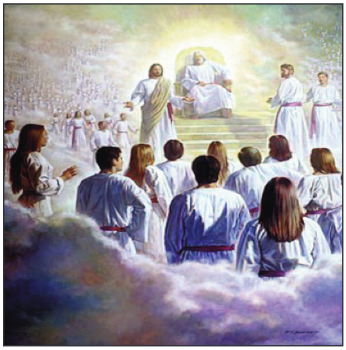 These people not possessing God’s spirit allowed fear to overpower them, and refused to listen to their “Husband” directly, which typified their failure to obey Him later on as they journied into the wilderness [Satan’s world]. What a far cry this was to the marriage supper in heaven right after the first resurrection, when the saints, possessing God’s spirit, will meet the Lamb in person.
These people not possessing God’s spirit allowed fear to overpower them, and refused to listen to their “Husband” directly, which typified their failure to obey Him later on as they journied into the wilderness [Satan’s world]. What a far cry this was to the marriage supper in heaven right after the first resurrection, when the saints, possessing God’s spirit, will meet the Lamb in person.
“Let us be glad and rejoice, and give honor to Him, for the marriage of the Lamb is come, and His wife has made herself ready. And to her was granted that she should be arrayed in fine linen, clean and white, for the fine linen is the righteousness of the saints. And He said unto me, Blessed are they which are called unto the marriage supper of the Lamb. And he said unto me, These are the true sayings of God” (Revelation 19:7-9).
These saints at the marriage supper express the same attitude of joy and peace toward their Husband as did the disciples at Pentecost in 30 A. D. Peter boldly recited Joel 2:28-30, and he and the other disciples proclaimed the message of Jesus Christ risen, and His blood atoning for the sins of all the elect … as well as the message of the coming Kingdom of God to reign on the earth (Acts 3:19-21), in which the saints are to reign for a thousand years. The entire prophetic timescale revolves around this very marriage of Jesus Christ and the saints, and the renewal of Eden upon the earth, an Eden which was lost when Adam and Eve first sinned.
These facts explain why the Book of Ruth is attached firmly to Pentecost, and is so often read during this feast. Boaz, a type of Christ, marries the young Moabitess (actually of Israelite descent) who has journeyed with her mother-in-law from the wilderness of Moab. The son of Boaz and Ruth—Obed—gave rise to Jesse, and Jesse to David, leading to Christ Himself, the One who is now residing in spirit within the saints, and is their head (I Corinthians 11:3), and their future Husband.
What Will It Be Like to Be Spirit?
What are the appearance and role of the resurrected saints during the coming age as they function as kings and priests? Our imaginations are not able to fully conjure up the reality of our future. Look at Isaiah 64:4 and I Corinthians 2:9. Despite the fact that we have never seen, heard, or imagined the reality of spirit life, yet God reveals that we can know at least some things of the spirit, even the “… deep things of God”, if we possess His spirit (I Corinthians 2:10-12).
1. Our appearance will be like Jesus Christ, but we will retain our unique identity, since we are brothers of Jesus Christ, not clones (Romans 8:29). Note Jesus Christ’s appearance to John (Revelation 1:12-15). Brilliant light will flow from us (I Corinthians 15: 42-43; Daniel 12:3; Matthew 13:43; 17:2).
2. A new name will be given (Revelation 2:17).
3. Never again will we die (Revelation 2:7, 11).
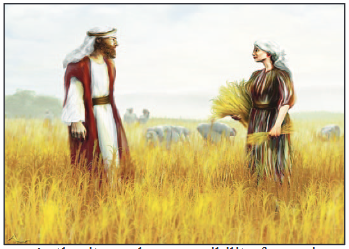 4. Our true home will be the New Jerusalem in the spirit world, placed on the earth, but our main effort and authority will be on the earth (Revelation 3:12, 21; 5:10; 20:4-6; 21:9-10). Authority and responsibility for various portions of the earth will be given (Luke 19:11-19). A literal Eden will be reconstructed over all the earth during the decades and centuries after Jesus Christ’s return, a reconstruction in which we will have a direct part (Acts 3:19-21; Micah 4:1-5; Isaiah 2:1-4; 11:6-9; 35:4-7; 65:17-25).
4. Our true home will be the New Jerusalem in the spirit world, placed on the earth, but our main effort and authority will be on the earth (Revelation 3:12, 21; 5:10; 20:4-6; 21:9-10). Authority and responsibility for various portions of the earth will be given (Luke 19:11-19). A literal Eden will be reconstructed over all the earth during the decades and centuries after Jesus Christ’s return, a reconstruction in which we will have a direct part (Acts 3:19-21; Micah 4:1-5; Isaiah 2:1-4; 11:6-9; 35:4-7; 65:17-25).
5. Like Jesus Christ we will inherit all things, but that inheritance is not something we will “sit on” as a miser does his gold. It will be developed and expanded forever (Revelation 21:7; Matthew 5:3, 5; Isaiah 9:7).
6. We will be worshiped even as Christ is worshiped, for we will be God (Revelation 3:9; Isaiah 49:23; 60:14).
7. We will no longer be able to sin (I John 3:9).
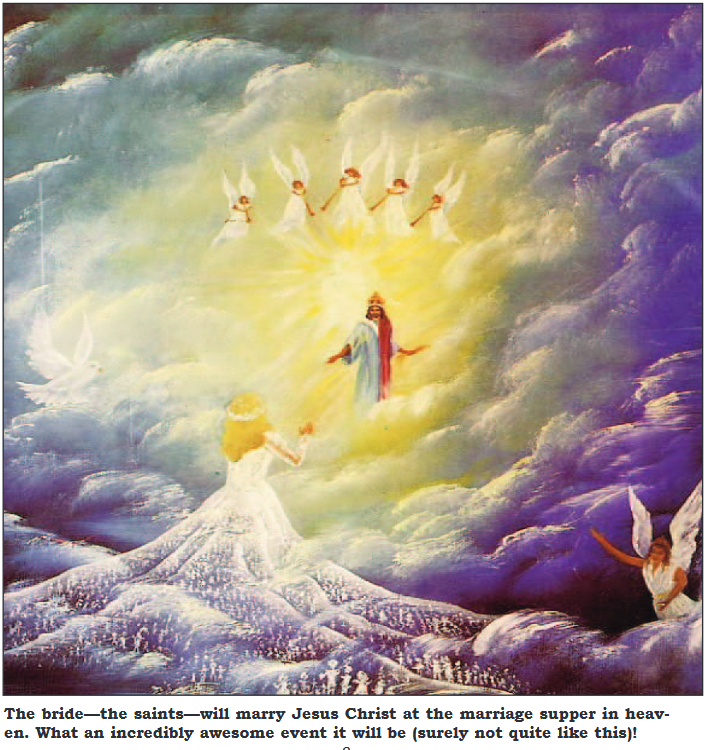
Imagine the spirit personage of Jesus Christ and the Father. That is our destiny, to become like Them! These are the messages of the day of Pentecost, and we ought to cling to them throughout the year, to give us hope and encouragement in the face of a world sold out to evil all around us.
